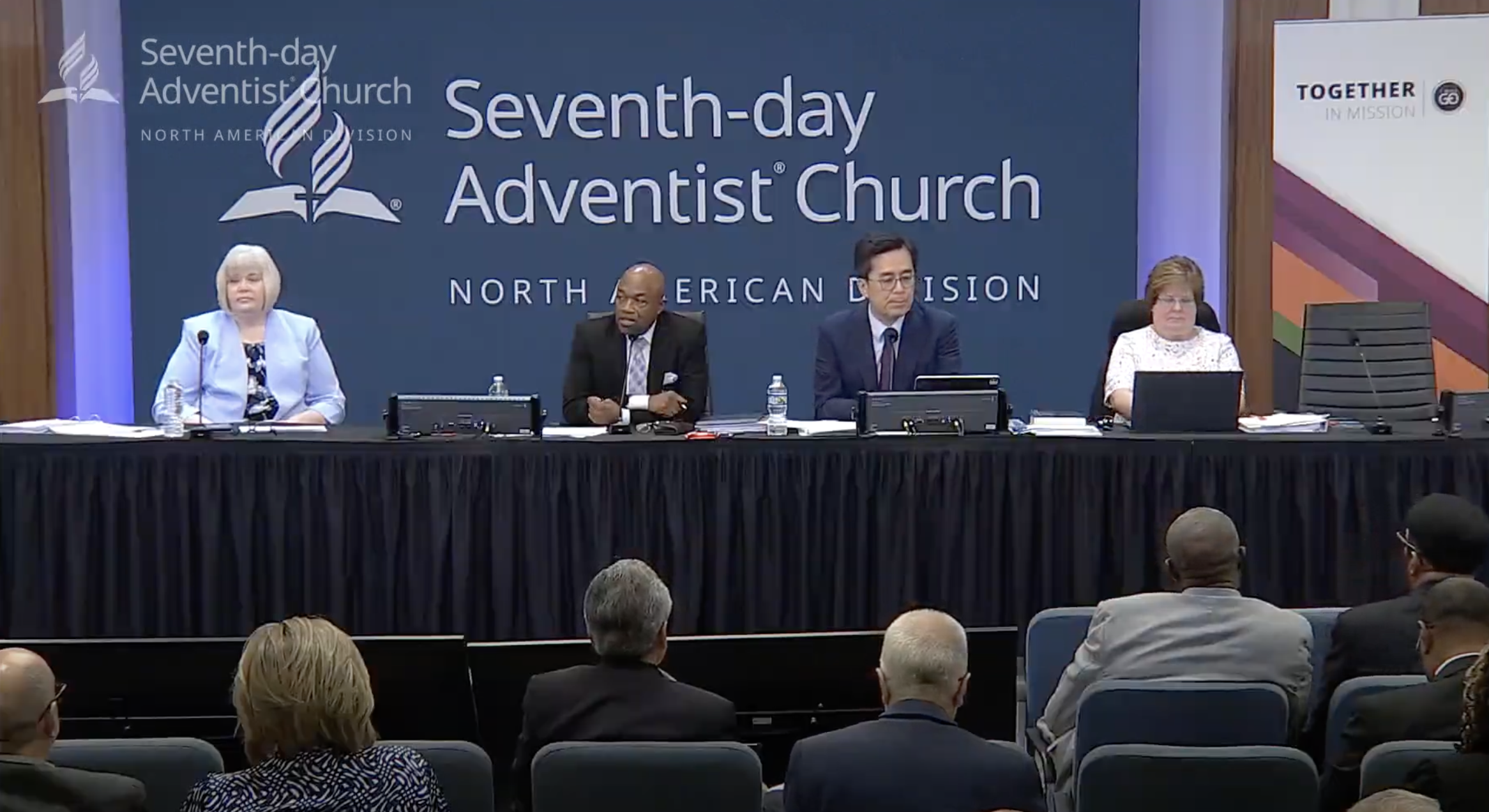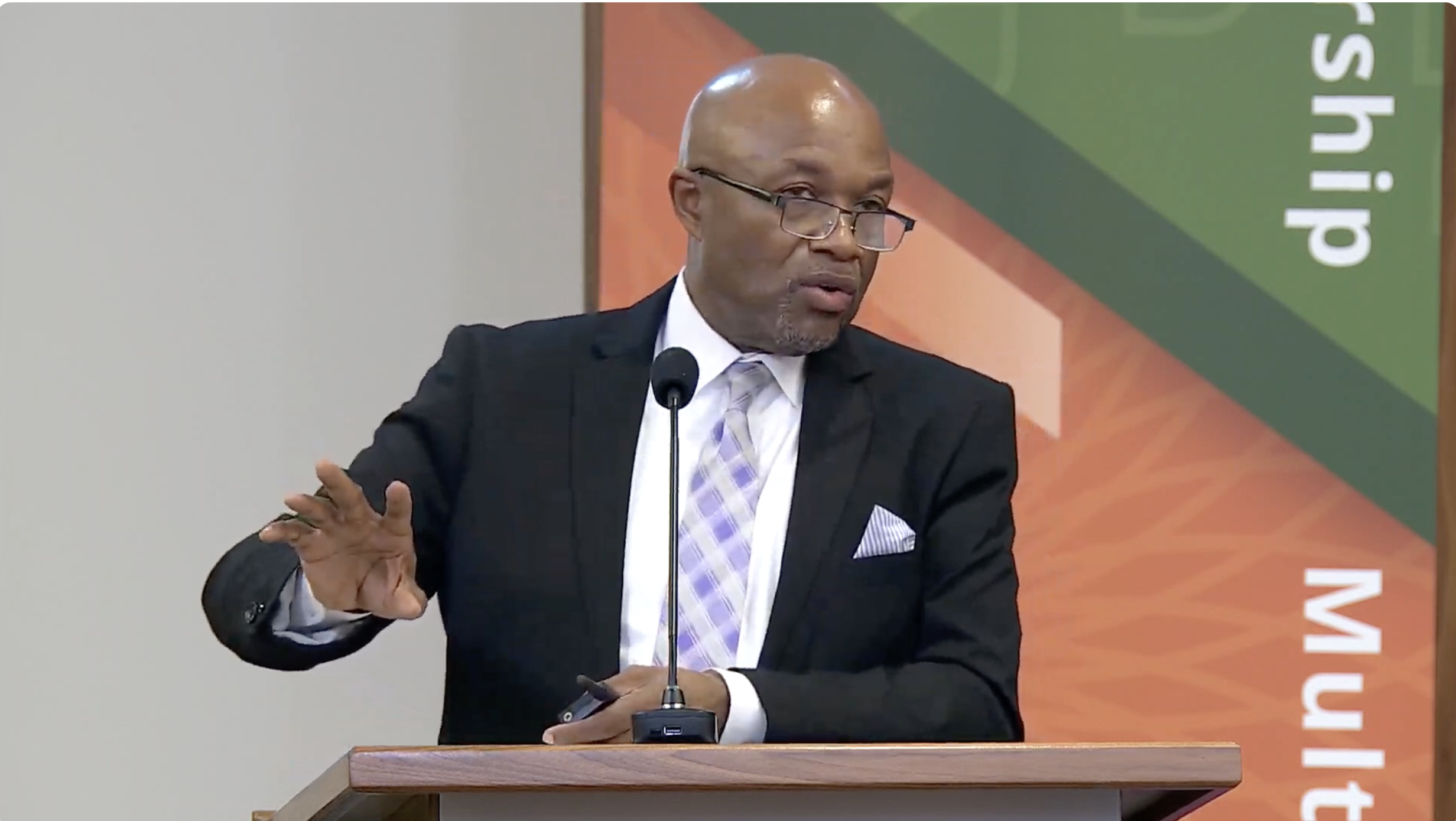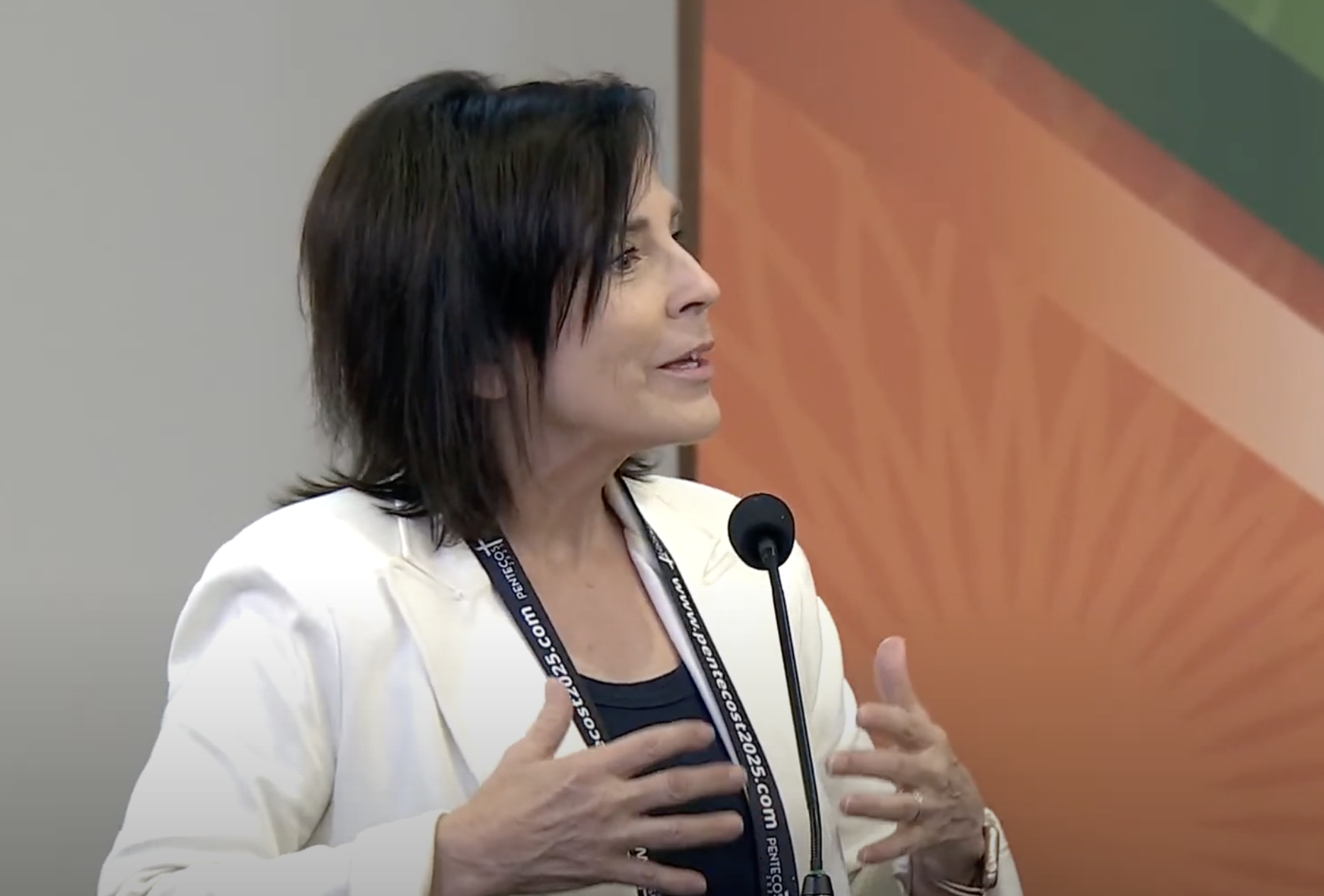
The North American Division convenes the 2024 year-end meeting on November 1. Screenshot of livestream
Day one of the North American Division’s Year-End Meeting (YEM) started with a reading of the division’s mission statement: “To reach North America and the world with a distinctive, Christ-centered message of hope and wholeness.”
G. Alexander Bryant, NAD president, called the meeting to order, and invited union presidents to stand and introduce new administrative members from their territories. Two union presidents are new this year, whom Bryant introduced: Marcellus Robinson, elected in March to the Columbia Union, and Abraham Jules, elected in June to the Atlantic Union.
During his introductions, Paul Llewellyn, president of the Adventist Church in Canada, commented that he would like to see a greater number of young leaders represented at the year-end meeting, and, as part of this effort, encouraged greater mentorship within the church.
Two leadership retirements were also announced; Mark Remboldt, treasurer for North Pacific Union Conference, and Berit von Pohle, vice president for education for Pacific Union Conference.
Bryant then introduced two “prayer conveners,” a tradition stemming from when Daniel Jackson was president of NAD. Anne-Marie Jacobs, principal at Burton Adventist Academy in Texas, and Leonard Menendez, pastor in Arkansas-Louisiana Conference, are this year’s prayer conveners.
“These two individuals have been asked to be particularly in tune with how the Spirit is moving in this room as we go about our meetings,” Bryant explained. “If the Spirit impresses them that prayer is needed, they are allowed to interrupt the proceedings at any time to lead us in prayer.”
To set the mood, Bryant then called for small groups to gather and pray for leadership and for all participants to set aside differences as meetings began.

G. Alexander Bryant, NAD president, gives his report to the executive committee at the 2024 year-end meeting on Nov. 1. Screenshot from livestream
Mission Minded
Bryant began his president’s report by reminding the group of the theme voted in 2021 for the next quinquennium: “Together in Mission.”*
There has been more change in leadership positions across the NAD in the last year than ever before in the history of the division, Bryant shared. “How do we stay together with this much change?” he asked. “How can we move together and yet make room for the individuality of the contexts we find ourselves in?”
The answer, Bryant shared, is mentorship, one of the three foci of NAD ministry. Paulo Macena, director of leadership for the NAD, then talked about the division’s new mentorship program, in which 35 conference presidents are currently working with coaches. Macena also shared that Adventist Learning Community is currently developing a certification in leadership.
“Media is definitely an area in which our youth and young adults can help lead the way,” Bryant said, introducing the next segment of his report. “We’re living in a new world of media and tech and as a church we’re barely scraping the surface of our potential.”
Adam Fenner, director of Adventist Learning Community, implored churches, schools, and ministries to do better with their digital footprints, and then showcased some of the many ways ALC can help.
“We’re up against TikTok influencers, Apple, Meta, and Microsoft, all with trillions of dollars in revenue with dedicated teams figuring out how they can get people’s attention,” Fenner said. “With the average person spending 2.5 to 4 hours on social media every day, if we want to get their attention, that’s where we have to be.”
Thanks to Adventist Information Ministry, beginning in spring 2025, every church entity will have a mobile-friendly website automatically generated, with options to upgrade for even greater customization — all for no additional cost, including training.
Another initiative AIM is working on is one single contact management platform, so churches can collaborate across territories in order to ensure anyone expressing interest in the church is connected to someone local in their area.
Paul Hopkins, director of Big Data + Social Media for the NAD, took the podium next and shared a brief demo of a dashboard his team has been working on, allowing church data to become visual to better inform decision-makers.
“In order to go fishing effectively, we have to know what kind of bait to use,” Bryant began his next segment. “And to know that, we have to understand what pond we’re fishing in, and what fish are in it.” He then shared a couple of colorful illustrations of the United States, one showing which denominations are strongest in each state, and another showing the religiosity of each state. “If we know what we’re up against in each area in which we want to evangelize, we can do so much more effectively,” he explained.
After a brief break, a question was asked about how the church is finding ways to use artificial intelligence in what it’s doing, to which Fenner replied that we should be cautious of what AI brings to the table for ministry. “As our society becomes more and more digital, the value added we bring to the table is our human presence,” he said. “People are craving human contact, and we can provide that. So let’s use AI to process information, but let’s never remove the human element from the equation.”

Sherri Uhrig, Children’s Ministries director for the NAD, gave an update on the new Seventh-day Adventist Church Sabbath School curriculum at YEM. Screenshot of livestream
Alive in Jesus
Sherri Uhrig, Children’s Ministries director for the NAD, gave an update on the new Seventh-day Adventist Church Sabbath School curriculum, “Alive in Jesus.” Phase I was completed in 2024, launching a curriculum for Baby Steps and Beginners (up to age 12 months) in 2025, after trainings at the conference level in all nine unions and Guam-Micronesia Mission. Phase II rolls out in 2026, offering curriculum for Kindergarten and Primary (through grade 3).
When the entire curriculum has been launched, the “Alive in Jesus” program will cover birth through 18 years. “This curriculum leads the whole family to know, love, and serve Jesus,” Uhrig concluded.
Brad Forbes, president of AdventSource, stood and asked church administrators to ask their churches what curriculum they’re using. An NAD poll from a few years ago revealed that around half of Sabbath Schools are using non-Adventist curriculum in their classes. “If you have influence, make sure your church signs up for Alive in Jesus,” Forbes said. “I can guarantee it will make a difference.”
Gary Rustad, president of Georgia-Cumberland Conference, requested a single curriculum to be used across Pathfinders, Adventurers, Sabbath School, and Adventist education classrooms. “I have three kids in different grades in Adventist schools and Sabbath School and two in Pathfinders,” Rustad commented. “That’s eight different curricula. Until we can streamline this, it won’t be as well-used as it could be.”
Adventist Media Ministry
Rick Remmers, president of Adventist Media Ministry, introduced a video update summary from all seven media ministries in the NAD: Voice of Prophecy, Jesus 101, Breath of Life, La Voz de la Esperanza, It Is Written, Faith for Today, and Lifetalk Radio. Highlights from those reports included:
- Voice of Prophecy, as the official media ministry of Pentecost 2025, is providing all the resources needed for churches to participate, including registration, for free.
- Jesus 101 has released its popular “Jesus Wins!” Bible study course in English so church members can begin hosting studies in tandem with Pentecost 2025.
- Breath of Life has released “Evie’s Treehouse,” a new audio devotional for kids. This year they also celebrated 50 years of ministry with a tour of Italy and Greece, following in the footsteps of Paul.
- La Voz de la Esperanza baptized more than 1,800 people around the world, and graduated 23,000 people through its Bible study courses. They have more than 120,000 subscribers on YouTube and are working on a health talks and recipes series.
- It Is Written received 14 Telly Awards in 2024 for outstanding broadcast content. Their Spanish arm, Escrito Está, is thriving, and they are planning an evangelistic series with Alex Bryant in Baltimore for next year called “Hope for Humanity.”
- Faith for Today hosts a live interactive Bible study on YouTube every Sabbath, and provides marriage and grief support programs for churches. They are also introducing life coaching and self-improvement resources.
- LifeTalk Radio has 276 station affiliates run by churches, conferences, and other entities around the globe. They also have over two dozen programs specifically for kids and free evangelistic resources for anyone who wants to use them.
Pentecost 2025
Throughout the meeting, “Pentecost 2025” was frequently referenced. This NAD effort kicks off in January. “It’s less about events taking place and more about the transformation we’re praying God will make in all of us,” Bryant explained. “We want that outpouring, indwelling of the Holy Spirit.”
Bryant commented that the Holy Spirit didn’t just suddenly show up at Pentecost; the Holy Spirit was already working before that. “Pentecost didn’t mean the disciples weren’t already working; it just meant they were going to take their work to another level and needed more of God’s Spirit,” he continued.
Three thousand were baptized at Pentecost, and the NAD determined to at least match that number in the total number of churches participating in Pentecost 2025. Currently there are 3,600 churches signed up to participate. (Churches interested in being part of Pentecost 2025 can register at Pentecost2025.com.)
“Pentecost is more than an event; it’s a clarion call to God’s people that we want to take it to the next level,” Bryant concluded. “It’s an admission we can’t do it on our own.”
Bryant closed with two questions on mission refocus: How can we ensure every church, large or small, is actively engaged in the mission for which Christ established the church? And how do we get every member involved in the mission of the church?
John Cress, president of Southern California Conference, closed the meeting with prayer. “Thank you for the business that has been done here today,” he prayed. “We have great anticipation of your spirit moving. Lead us and guide us in all that we do, and please be our honored guest every day as we meet here together. Amen.”
*A fuller summary of the president's report will be published soon.
